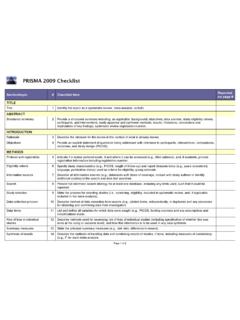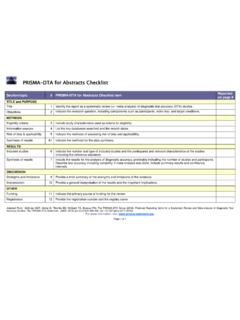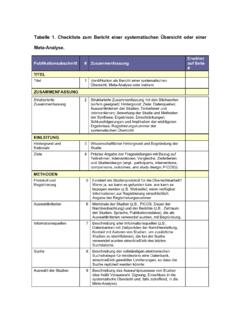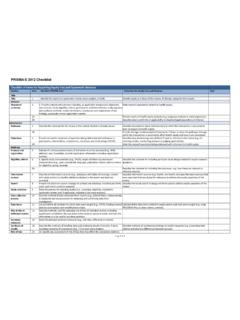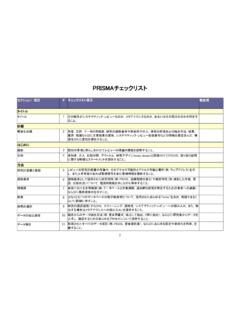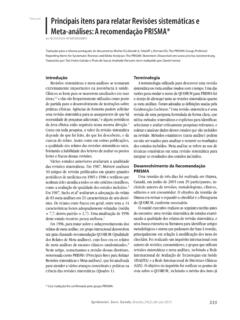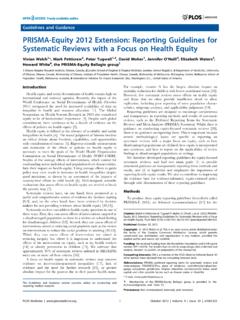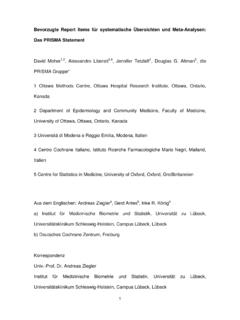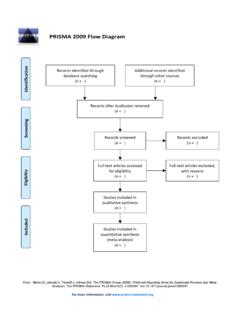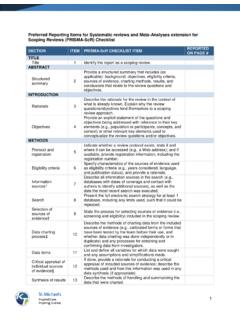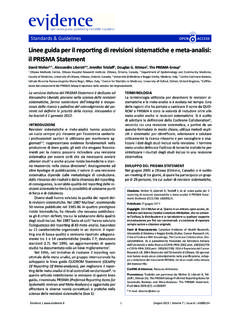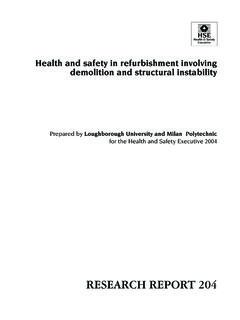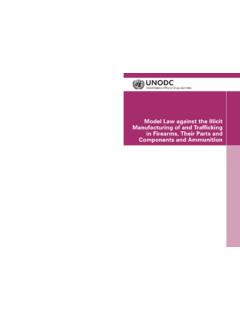Transcription of The PRISMA Statement for Reporting Systematic Reviews and ...
1 Guidelines and Guidance 1. The PRISMA Statement for Reporting Systematic Reviews and Meta-Analyses of Studies That Evaluate Health Care Interventions: Explanation and Elaboration Alessandro Liberati1,2*, Douglas G. Altman3, Jennifer Tetzlaff4, Cynthia Mulrow5, Peter C. G tzsche6, John P. A. Ioannidis7, Mike Clarke8,9, P. J. Devereaux10, Jos Kleijnen11,12, David Moher 4,13. 1 Universita` di Modena e Reggio Emilia, Modena, Italy, 2 Centro Cochrane Italiano, Istituto Ricerche Farmacologiche Mario Negri, Milan, Italy, 3 Centre for Statistics in Medicine, University of Oxford, Oxford, United Kingdom, 4 Ottawa Methods Centre, Ottawa Hospital Research Institute, Ottawa, Ontario, Canada, 5 Annals of Internal Medicine, Philadelphia, Pennsylvania, United States of America, 6 The Nordic Cochrane Centre, Copenhagen, Denmark, 7 Department of Hygiene and Epidemiology, University of Ioannina School of Medicine, Ioannina, Greece, 8 UK Cochrane Centre, Oxford, United Kingdom, 9 School of Nursing and Midwifery, Trinity College, Dublin, Ireland, 10 Departments of Medicine, Clinical Epidemiology and Biostatistics, McMaster University, Hamilton, Ontario, Canada, 11 Kleijnen Systematic Reviews Ltd, York, United Kingdom, 12 School for Public Health and Primary Care (CAPHRI)
2 , University of Maastricht, Maastricht, The Netherlands, 13 Department of Epidemiology and Community Medicine, Faculty of Medicine, Ottawa, Ontario, Canada Recent data suggest that at least 2,500 new Systematic Reviews Abstract: Systematic Reviews and meta-analyses are reported in English are indexed in MEDLINE annually [3]. essential to summarize evidence relating to efficacy and Unfortunately, there is considerable evidence that key informa- safety of health care interventions accurately and reliably. tion is often poorly reported in Systematic Reviews , thus The clarity and transparency of these reports, however, is diminishing their potential usefulness [3,4,5,6]. As is true for all not optimal. Poor Reporting of Systematic Reviews research, Systematic Reviews should be reported fully and diminishes their value to clinicians, policy makers, and transparently to allow readers to assess the strengths and other users. Since the development of the QUOROM. (QUality Of Reporting Of Meta-analysis) Statement a weaknesses of the investigation [7].
3 That rationale led to the Reporting guideline published in 1999 there have been development of the QUOROM (QUality Of Reporting Of Meta- several conceptual, methodological, and practical advanc- analyses) Statement ; those detailed Reporting recommendations es regarding the conduct and Reporting of Systematic were published in 1999 [8]. In this paper we describe the updating Reviews and meta-analyses. Also, Reviews of published Systematic Reviews have found that key information about these studies is often poorly reported. Realizing these Citation: Liberati A, Altman DG, Tetzlaff J, Mulrow C, G tzsche PC, et al. (2009) The issues, an international group that included experienced PRISMA Statement for Reporting Systematic Reviews and Meta-Analyses of authors and methodologists developed PRISMA (Preferred Studies That Evaluate Health Care Interventions: Explanation and Reporting Items for Systematic Reviews and Meta-Analy- Elaboration. PLoS Med 6(7): e1000100. ses) as an evolution of the original QUOROM guideline for Published July 21, 2009.
4 Systematic Reviews and meta-analyses of evaluations of Copyright: 2009 Liberati et al. This is an open-access article distributed health care interventions. The PRISMA Statement con- under the terms of the Creative Commons Attribution License, which permits sists of a 27-item checklist and a four-phase flow diagram. unrestricted use, distribution, and reproduction in any medium, provided the The checklist includes items deemed essential for original author and source are credited. transparent Reporting of a Systematic review. In this Funding: PRISMA was funded by the Canadian Institutes of Health Research;. Explanation and Elaboration document, we explain the Universita` di Modena e Reggio Emilia, Italy; Cancer Research UK; Clinical Evidence meaning and rationale for each checklist item. For each BMJ Knowledge; The Cochrane Collaboration; and GlaxoSmithKline, Canada. AL is funded, in part, through grants of the Italian Ministry of University (COFIN - PRIN. item, we include an example of good Reporting and, 2002 prot.)
5 2002061749 and COFIN - PRIN 2006 prot. 2006062298). DGA is funded where possible, references to relevant empirical studies by Cancer Research UK. DM is funded by a University of Ottawa Research Chair. and methodological literature. The PRISMA Statement , None of the sponsors had any involvement in the planning, execution, or write-up this document, and the associated Web site (http://www. of the PRISMA documents. Additionally, no funder played a role in drafting the manuscript. ) should be helpful resources to improve Reporting of Systematic Reviews and meta- Competing Interests: MC's employment is as Director of the UK Cochrane Centre. He is employed by the Oxford Radcliffe Hospitals Trust on behalf of the analyses. Department of Health and the National Institute for Health Research in England. This is a fixed term contract, the renewal of which is dependent upon the value placed upon his work, that of the UK Cochrane Centre, and of The Cochrane Collaboration more widely by the Department of Health.
6 His work involves the Introduction conduct of Systematic Reviews and the support of the conduct and use of Systematic Reviews . Therefore, work such as this manuscript relating to Systematic Reviews and meta-analyses are essential tools for Systematic Reviews might have an impact on his employment. summarizing evidence accurately and reliably. They help Abbreviations: PICOS, participants, interventions, comparators, outcomes, and clinicians keep up-to-date; provide evidence for policy makers to study design; PRISMA , Preferred Reporting Items for Systematic Reviews and Meta-Analyses; QUOROM, QUality Of Reporting Of Meta-analyses. judge risks, benefits, and harms of health care behaviors and interventions; gather together and summarize related research for * E-mail: patients and their carers; provide a starting point for clinical Provenance: Not commissioned; externally peer reviewed. In order to practice guideline developers; provide summaries of previous encourage dissemination of the PRISMA explanatory paper, this article is freely accessible on the PLoS Medicine, Annals of Internal Medicine, and BMJ Web sites.
7 Research for funders wishing to support new research [1]; and help The authors jointly hold the copyright of this article. For details on further use see editors judge the merits of publishing reports of new studies [2]. the PRISMA Web site ( ). PLoS Medicine | 1 July 2009 | Volume 6 | Issue 7 | e1000100. of that guidance. Our aim is to ensure clear presentation of what Box 1. Terminology was planned, done, and found in a Systematic review. Terminology used to describe Systematic Reviews and meta- The terminology used to describe Systematic Reviews and analyses has evolved over time and varies across different groups of meta-analyses has evolved over time and varies between researchers and authors (see Box 1). In this document we adopt the fields. Different terms have been used by different groups, definitions used by the Cochrane Collaboration [9]. A Systematic such as educators and psychologists. The conduct of a review attempts to collate all empirical evidence that fits pre- Systematic review comprises several explicit and repro- specified eligibility criteria to answer a specific research question.
8 Ducible steps, such as identifying all likely relevant records, It uses explicit, Systematic methods that are selected to minimize selecting eligible studies, assessing the risk of bias, extracting data, qualitative synthesis of the included bias, thus providing reliable findings from which conclusions can studies, and possibly meta-analyses. be drawn and decisions made. Meta-analysis is the use of statistical Initially this entire process was termed a meta-analysis methods to summarize and combine the results of independent and was so defined in the QUOROM Statement [8]. More studies. Many Systematic Reviews contain meta-analyses, but not recently, especially in health care research, there has been a all. trend towards preferring the term Systematic review. If quantitative synthesis is performed, this last stage alone is The QUOROM Statement and Its Evolution into referred to as a meta-analysis. The Cochrane Collaboration PRISMA uses this terminology [9], under which a meta-analysis, if performed, is a component of a Systematic review.
9 The QUOROM Statement , developed in 1996 and published Regardless of the question addressed and the complexities in 1999 [8], was conceived as a Reporting guidance for authors involved, it is always possible to complete a Systematic Reporting a meta-analysis of randomized trials. Since then, much review of existing data, but not always possible, or has happened. First, knowledge about the conduct and Reporting desirable, to quantitatively synthesize results, due to clinical, of Systematic Reviews has expanded considerably. For example, methodological, or statistical differences across the includ- The Cochrane Library's Methodology Register (which includes ed studies. Conversely, with prospective accumulation of reports of studies relevant to the methods for Systematic Reviews ) studies and datasets where the plan is eventually to now contains more than 11,000 entries (March 2009). Second, combine them, the term (prospective) meta-analysis''. there have been many conceptual advances, such as outcome- may make more sense than Systematic review.
10 ''. For retrospective efforts, one possibility is to use the level'' assessments of the risk of bias [10,11], that apply to term Systematic review for the whole process up to the Systematic Reviews . Third, authors have increasingly used point when one decides whether to perform a quantitative Systematic Reviews to summarize evidence other than that synthesis. If a quantitative synthesis is performed, some provided by randomized trials. researchers refer to this as a meta-analysis. This definition However, despite advances, the quality of the conduct and is similar to that found in the current edition of the Reporting of Systematic Reviews remains well short of ideal Dictionary of Epidemiology [183]. [3,4,5,6]. All of these issues prompted the need for an update While we recognize that the use of these terms is and expansion of the QUOROM Statement . Of note, recognizing inconsistent and there is residual disagreement among the that the updated Statement now addresses the above conceptual members of the panel working on PRISMA , we have adopted and methodological issues and may also have broader applicability the definitions used by the Cochrane Collaboration [9].
